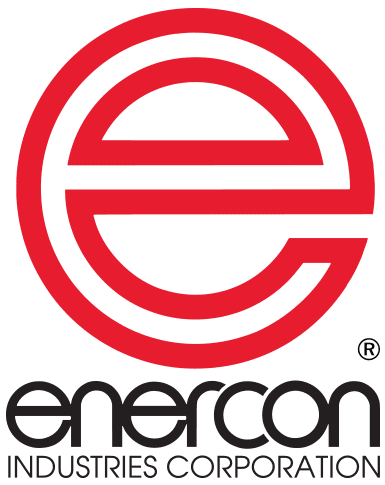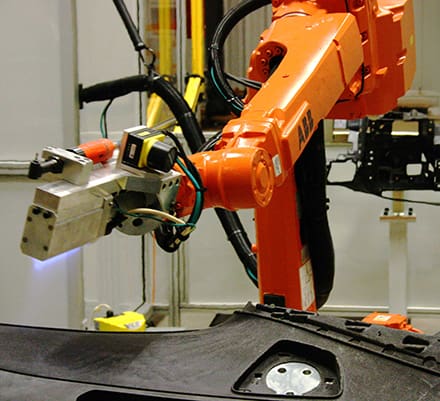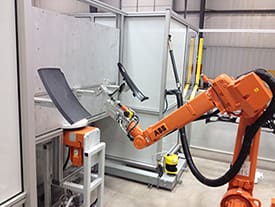Application Engineer’s Guide for using Plasma Treatment to Improve Adhesion
Plasma Surface Treatment is being used in dozens of industries for hundreds of applications. This 30-minute webinar provides insights into how engineers are using atmospheric plasma surface treating systems to improve surface bonding of inks, adhesives and coatings. This webinar includes: Access to the webinar includes both the recorded presentation and the presentation slides.
Read MorePlasma & Flame Improve Adhesion for Composite Materials
The need to lightweight materials while maintaining structural properties have automotive design engineers rapidly integrating plastics and composites into their latest products. Composite materials provide superior mechanical performance, reduced weight, corrosion resistance, and the flexibility of part design. With this evolution of materials incorporating in-line surface treatment has become vital to helping promote adhesion, improve…
Read MoreImprove Structural Composite Adhesion Strength with in-line Plasma Surface Treatment
Whether you are looking to improve the consistency of structural composite adhesion or improve the productivity of your process; in-line atmospheric plasma surface treatment may be the answer. Join Composite Adhesion expert Lou Dorworth of Abaris Training Resources, Inc and surface treatment expert Ryan Schuelke of Enercon Industries Corporation for an informative webinar on structural…
Read MorePlasma & Flame Surface Treating Comparison Guide
Plasma & flame surface treaters clean, etch & functionalize surfaces to enable bonding with inks, adhesives, paints & coatings on plastics, composites, glass & metal. But how are they similar and how are they different? Air Plasma Air plasma is formed by blowing atmospheric air past high-voltage powered electrodes and is sometimes referred to as…
Read MorePlasma Treatment for Adhesion Promotion of High Performance Materials used in Aerospace Manufacturing
The aerospace industry is taking advantage of alternative methods to improve the adhesion of adhesively-bonded joints of polymers and composites. Manufacturers are using atmospheric plasma to prepare surfaces for bonding to similar and dissimilar materials. Process and reactive gas components rapidly activate polymer surfaces, providing surface species which contribute to secure bonding and curing of…
Read MoreHenkel Adhesives & Enercon Plasma Treatment Case Study:
Surface Treatment Effects on Adhesive Bond Strength Henkel and Enercon Industries partnered in this study to compare the effects of adhesives’ bond strength on fluoropolymers when they are pre-treated with a variety atmospheric plasma technologies. This paper takes an in-depth look at necessary alignments between the substrate type, surface modification method, and adhesive type to…
Read MoreFlame Treatment Automotive Dashboard to Improve Paint Adhesion Video
Enercon’s Flame Series surface treater treats an EVA automotive dashboard prior to painting. Treatment raise surface energy to promote paint adhesion. The flame treater is integrated with a robot that executes a treatment pattern based on a program actuated by a bar code scan on the part.
Read MoreFlame Treatment of Automotive Dashboard Improves Foam Adhesion Video
Enercon partnered with Midwest Engineering to develop a production ready flame treatment system for an automotive dashboard supplier. The goal of the system is to increase the receptiveness of the EVA dashboard surface to an adhesive which will hold foam padding in place. Enercon’s flame treater is integrated with a robot for precise treatment patterns…
Read MoreRobotic Integration of Flame Treatment for Automotive Assembly Video
Enercon’s Flame treater is used by automotive manufacturers for a variety of applications such as bumpers, dashboards, consoles, glove boxes and air bags. The flame treater cleans the surface of contaminates to improve adhesion prior to applying an adhesive, paint or coating. For this project, Enercon’s Flame treater was integrated by MWES with an ABB robot. It…
Read MoreWhat Plasma Treating Does to a Surface Video Animation
Plasma Treatment cleaning, etching and functionalizing Atmospheric plasma treatment is used by manufacturers, converters and packagers to improve surface energy and adhesion. The animations below show how the process effectively functionalizes surfaces. These treatment systems diffuse reactive gases toward the surface under the influence of electrical fields. Low molecular weight materials such as water, absorbed…
Read More










